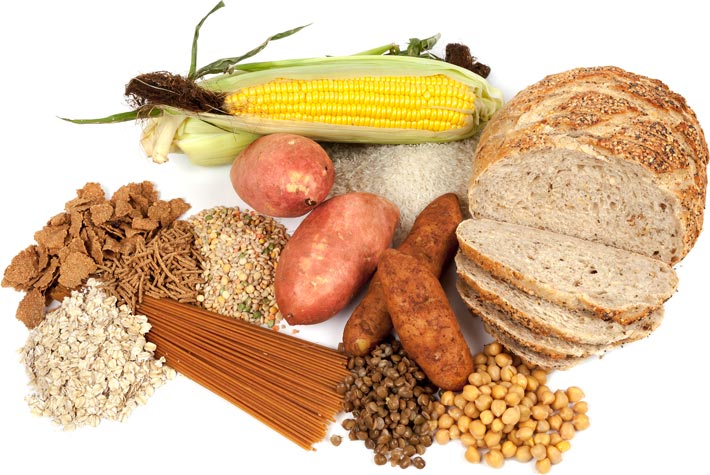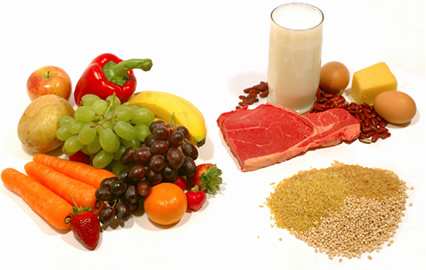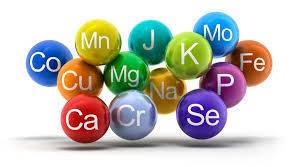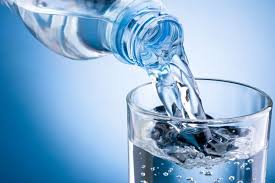IMPORTANT THINGS TO KNOW ABOUT THE MAIN ELEMENTS OF NUTRIENTS
 A healthy diet is intended to provide all the necessary nutrients for the functioning of the body and for this reason it must be as varied as possible. Our body needs macronutrients and micronutrients, which we daily get from nutrition.
A healthy diet is intended to provide all the necessary nutrients for the functioning of the body and for this reason it must be as varied as possible. Our body needs macronutrients and micronutrients, which we daily get from nutrition.
Macronutrients are essential for growth and metabolism and they must be taken daily in quantities greater than tens of grams. This category includes carbohydrates, proteins and lipids.
Micronutrients, on the other hand, are required by our body in amounts less than the daily gram, and are divided into vitamins and minerals.
Micronutrients are necessary for the production of enzymes and hormones. They intervene in the regulation of growth, development, regulation of the immune system and reproductive system.
Following the recommendations provided by LARN (Nutrient and Energy Reference Intake Levels), macronutrients should be broken down in the following proportions throughout the day:
- Carbohydrates 55-60%
- Protein 10-15%
- Lipids 25-30%
1. CARBOHYDRATES
 Carbohydrates are “fuel” for our body. Consequently, they are the first substances used by the body to obtain energy. One gram of carbohydrates provides 4 kcal. There are two types of carbohydrates: simple and complex.
Carbohydrates are “fuel” for our body. Consequently, they are the first substances used by the body to obtain energy. One gram of carbohydrates provides 4 kcal. There are two types of carbohydrates: simple and complex.
Simple carbohydrates, also called sugars, are easily digested and absorbed so they pass quickly into the bloodstream, providing energy. The most important sugars are: sucrose (the common table sugar), glucose and fructose (present in fruit) and lactose (present in milk). Simple sugars should not exceed 10% of the total daily calories.
Examples of foods with high content in simple sugars: jam, honey, candy, confectionery products, carbonated and non-carbonated drinks containing sugar.
Complex carbohydrates, on the other hand, take longer to be broken down and therefore absorbed. They are essentially represented by starch and fiber.
Starch is a compound consisting of the union of many glucose molecules. During the digestion process these molecules are released slowly, ensuring a supply to the body. Starch is mainly contained in cereals, legumes and potatoes.
Dietary fiber is made of carbohydrates that are not digestible and therefore not absorbed by the body. This means that the fiber passes through the stomach, intestine and colon without being digested, and in the latter, undergo fermentation by the bacterial flora.
Fiber has several beneficial effects on the body:
- It helps keep your body weight under control
- It improves bowel function
- It has a prebiotic effect (they promote the formation of beneficial bacteria at the expense of pathogenic bacteria)
- It has a protective role in relation to certain cancers
- It helps prevent and control diabetes by acting on nutrient absorption
The fiber is divided into two classes: insoluble and soluble.
Insoluble fiber (cellulose, hemicellulose and lignin) is mainly contained in cereals, vegetables and fruit. Its function is to absorb water, increasing the volume of feces, and stimulating the speed of transit in the intestinal lumen.
Soluble fiber (pectin) is mainly found in fruit and legumes. Its function is to form viscous solutions that slow down the absorption of sugars and fats and consequently the emptying of intestinal.
Based on their characteristics, insoluble fibers are recommended in case of constipation and diverticulitis, while soluble fibers are indicated in case of diabetes and hypercholesterolemia.
Examples of foods with high content in complex carbohydrates: cereals (wheat, spelt, rice, corn, oats, barley, millet, buckwheat and in their transformations, namely bread, pasta, dry toast, crackers, biscuits, polenta, etc.), potatoes, legumes.
2. PROTEINS

Proteins are the “bricks” that make up our body. Their use is mainly in the construction of tissues and organs, but they also have an important immune and hormonal function. In the absence of carbs, proteins can be used to produce energy.
One gram of protein provides 4 kcal, and the daily amount of protein to be introduced with the diet is between 0.8 and 1 grams of body weight.
Proteins are organic molecules containing carbon, oxygen, nitrogen, hydrogen and at times, sulphur phosphorus. They are linear chains of amino acids.
Amino acids are divided into essential and non-essential acids. Essential acids must be got through food while the non-essential ones can be synthesized by the organism itself.
Proteins can be found in different amounts in food of both of animal origin (meat, fish, eggs, dairy products) and vegetable origin (legumes, dried fruits, soybeans, cereals and derivatives).
It is necessary, however, to clarify that proteins are present in many foods. Proteins can vary in quantity and quality.
Animal proteins are called proteins with a high biological value and this is because they provide all the essential amino acids to meet metabolic demands. Whereas plant proteins have some deficiencies in regard to essential amino acids.
To overcome this drawback, it is enough to combine legumes with cereals, so as to get the correct amino acid pool and not have deficiencies.
3. LIPIDS
Lipids, which represent the nutrient with the highest energy value (one gram contains 9 kcal), are stored in fatty tissue and used when needed. In addition, they are essential for tissue isolation, digestion and absorption of fat-soluble vitamins. Lipid hydrolysis in many cases leads to the release of fatty acids. Fatty acids, based on their chemical characteristics, can be divided into 3 categories:
Monounsaturated fats (MUFA) and polyunsaturated (PUFA)
Monounsaturated fats maintain a good balance of LDL and HDL cholesterol in the blood, protect against cellular oxidation and certain types of cancer such as breast cancer.
A main source of monounsaturated fats is extra virgin olive oil.
Polyunsaturated fats can be divided into two classes: omega 3 and omega 6.
Omega 3s are mainly found in fish (salmon, anchovy, sardine, herring, mackerel), fish oil, flaxseeds and nuts.
Omega 6s are mainly found in vegetable oils (turnips, soybeans and sunflower). According to LARN there should be a correct ratio between omega 6 omega 3 in the diet. However, an optimal ratio has not been defined, as this could be misleading. In general, a balanced ratio is achieved by limiting omega 6 and keeping omega 3 high. In the general population the ratio is very unbalanced (in favour of omega 6, in proportion to 15:1). This imbalance is not good for the body as it is the cause of pro-inflammatory action.
Saturated fats
Saturated fats are mostly found in animal foods (meat and derivatives, milk and derivatives, lard), but also in plant-based foods (coconut oil, palm oil and cocoa butter); 10% of the total daily calories in the diet should be in saturated fats. However, a diet too rich in saturated fatty acids increases blood cholesterol levels, causing atherosclerosis (accumulation of cholesterol on the walls of the arteries), thus reducing blood flow.
Trans fats
Trans fats derive from unsaturated fats, which have undergone an industrial process, thus becoming comparable to saturated fats. They are mainly present in high quantities in hydrogenated fats, therefore in foods that contain margarines or have been fried in hydrogenated oils. Trans fatty acids increase risk factors for cardiovascular disease and organic inflammation. Fats are not biosynthesized by the human body and are not essential, so they should not be present in the diet.
4. VITAMINS

Vitamins are a very heterogeneous set of substances, which we obtain through nutrition as our body is not able to synthesize them. They are indispensable for metabolic processes but do not represent a source of energy.
They are divided into:
- Liposoluble, that is, fat soluble (A, D, E, K), are absorbed together with fats and accumulated in the liver. It is therefore not necessary to introduce them daily through our diet;
- Water-soluble (C, B1, B2, B3, B5, B6, B7, B9, B12), are not accumulated by the body so they must be taken daily with nutrition.
It is important to note that a balanced diet provides all the necessary of vitamins for our body.
Where do we find these vitamins?
|
VITAMIN A
|
liver (both land and sea animals), eggs, fish (fresh tuna, eel, etc.), tomatoes, red peppers, carrots, yellow melon |
|
VITAMIN D
|
certain types of fish (herring, mackerel, sardines, fresh tuna, etc.), eggs, cod liver oil |
|
VITAMIN E
|
seeds and consequently in the oils derived from them (soy oil, corn oil, olive oil, wheat germ oil) |
|
VITAMIN K
|
green leafy vegetables (broccoli, lettuce, spinach), soybeans oil, olive oil |
|
VITAMIN C
|
peppers, kiwis, citrus fruits, strawberries, tomatoes, green leafy vegetables
|
|
VITAMIN B1
|
whole grains, dried legumes, nuts |
|
VITAMIN B2
|
cheeses, liver, eggs, leafy green vegetables |
|
VITAMIN B3
|
liver, fish, chicken meat, beef and pork, wheat bran, whole meal flour |
|
VITAMIN B5
|
fish eggs, offal, egg yolk, legumes
|
|
VITAMIN B6
|
beef, fatty fish (tuna and salmon), chicken meat
|
|
VITAMIN B9
|
chicken liver, beef kidney, asparagus, broccoli, artichokes, spinach, fresh beans, peas, oranges, kiwi, strawberries |
|
VITAMIN B12
|
liver, fish (herring, shellfish, crustaceans), egg yolk, parmesan
|
5. MINERALS
 Minerals are inorganic elements which are fundamental for the biological functions of the organism and for growth. Their daily requirements vary in relation to the physiological conditions of the individual and age.
Minerals are inorganic elements which are fundamental for the biological functions of the organism and for growth. Their daily requirements vary in relation to the physiological conditions of the individual and age.
A varied and correct diet can usually meet the needs of mineral salts.
Mineral salts can be divided into:
- Macro elements: present in the body in discrete quantities. The daily requirement is in the order of grams or tenths of a gram (calcium, phosphorus, potassium, sodium, chlorine, sulphur, magnesium)
- Oligo elements or microelements: present only in traces in the body, the daily requirement ranges from a few micrograms to a few milligrams (iron, zinc, copper, iodine, fluoride, chromium, cobalt, silicon, vanadium, selenium, tin, manganese, nickel, molybdenum)
Before taking mineral salt supplements it is still essential to check, by means of a blood test, if you are really deficient. An inadequate or excessive intake could potentially be very dangerous e.g. An excess in potassium could result in fatal cardiac arrhythmias.
6. WATER
 Water is an essential element which makes up about 55% of a woman’s body weight and 60% of a man. In the human body water is essential for biochemical reactions, regulation of body temperature and the elimination of minerals and organic substances. It also plays a crucial role in digestion, absorption, transport and nutrient use.
Water is an essential element which makes up about 55% of a woman’s body weight and 60% of a man. In the human body water is essential for biochemical reactions, regulation of body temperature and the elimination of minerals and organic substances. It also plays a crucial role in digestion, absorption, transport and nutrient use.
The daily intake of water should be between 2 and 2.5 liters. It is important to drink consistently throughout the day and in moderation during meals. We must not wait until we are thirsty as this means that we are in a state of dehydration.


